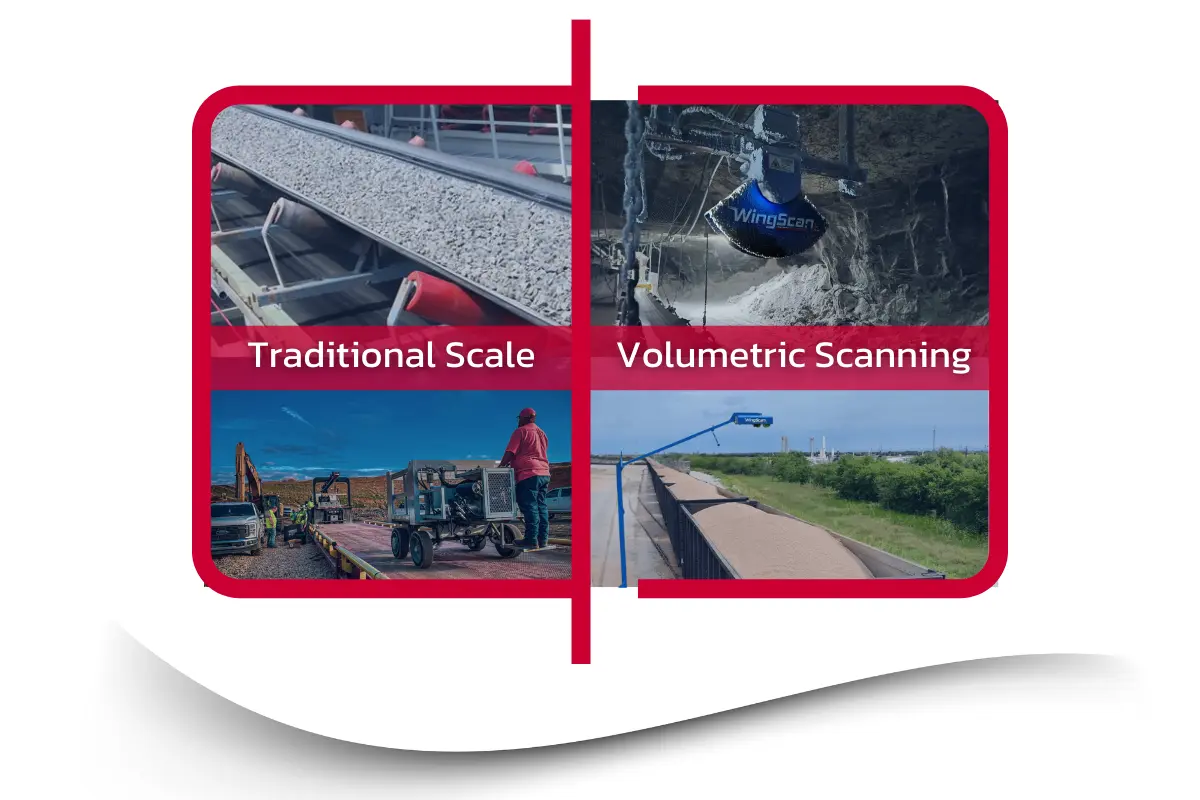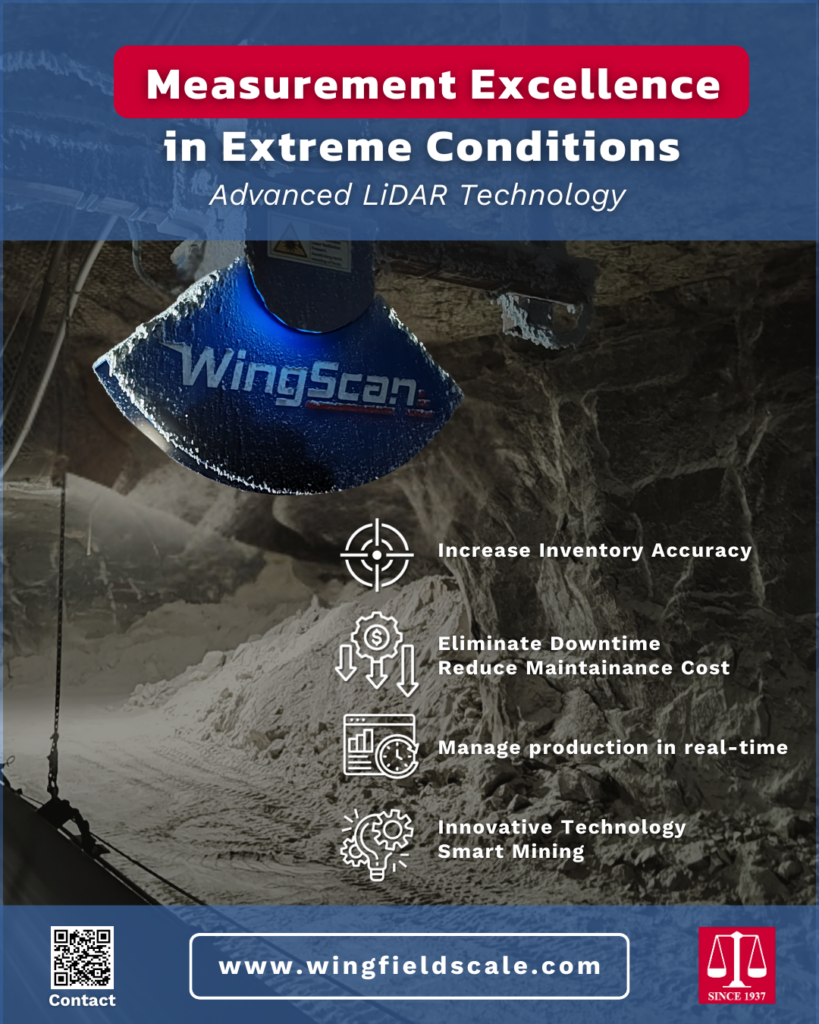Since you’re here, you’re probably interested in volumetric scanning vs. scale…
Want to know something interesting?
WingScan has spent the last 6 years diving deep into measurement systems at quarries across the United States.
And here’s what kept coming up: operators are stuck between two worlds – the traditional scale systems they’ve always used, and this newer volumetric scanning technology that’s been making waves.
Mine operations have involved scales with their quarry measurement for pretty much forever.
Traditional scales like weighbridges, platform scales, and belt scales are straightforward and familiar.
That’s why you see them everywhere, from small operations to massive sites.
But something’s changing in the mining industry right now.
More and more operators are exploring industrial volume scanning options because they’re seeing some real differences in their operations.
They’re discovering new ways to track quarry output that go beyond traditional methods, and the benefits are impossible to ignore.
So, this article breaks down exactly what we found, including those conveyor belt scale inaccuracies nobody talks about and the surprising stuff about both systems.
FAIR WARNING: This isn’t going to be one of those “everything you’re doing is wrong” pieces.
Instead, I’m going to walk you through what actually matters when you’re choosing between these systems.
Let’s dig into the details…
Why Compare Volumetric Scanning vs Scale?
Here’s something most equipment vendors won’t tell you straight up…
Making the wrong call on your measurement system is like throwing money into your crusher – except nothing valuable comes out the other end.
Let me break this down:
Traditional scales (you know, your weighbridges and conveyor belt scales) do exactly what they say on the tin – they weigh stuff.
Simple as that.
But here’s where it gets interesting…
Volumetric scanning? It’s playing a whole different game.
It creates a complete 3D profile of every load that rolls through.
It’s kind of like getting a CAT scan of your material.
And yes, it’ll give you weight too (as long as you know your material density).
Now, let’s get a clear look at how these systems stack up:
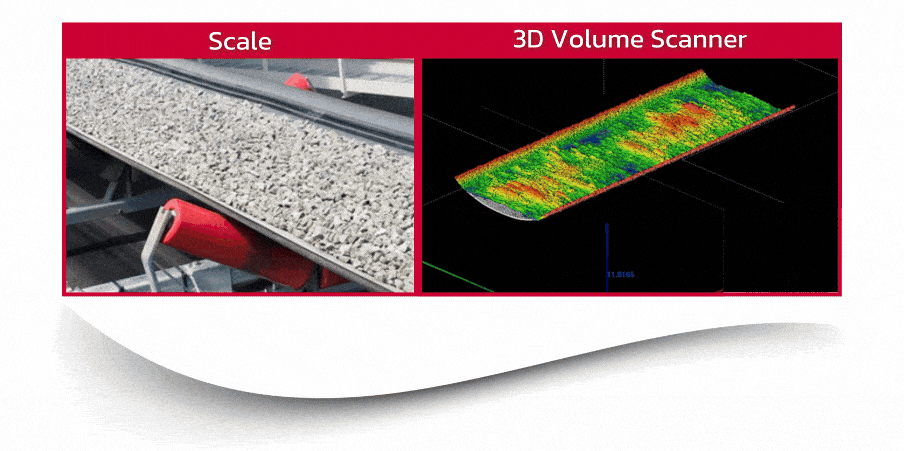
- Scales are a time-tested standard for weight accuracy, but they can face calibration challenges.
- Volumetric scanners offer speed, portability, and in-depth load data, yet they require density inputs to achieve precise weight calculations.
We’re about to dive deep into the nitty-gritty differences between these technologies.
And I’m going to show you exactly how volumetric scanner benefits might be the answer to those headaches your weighbridges and belt scales keep giving you.
Trust me, this gets interesting…
Common Issues with Traditional Scales
First, let’s examine some of the common issues associated with traditional scales in the mining industry.
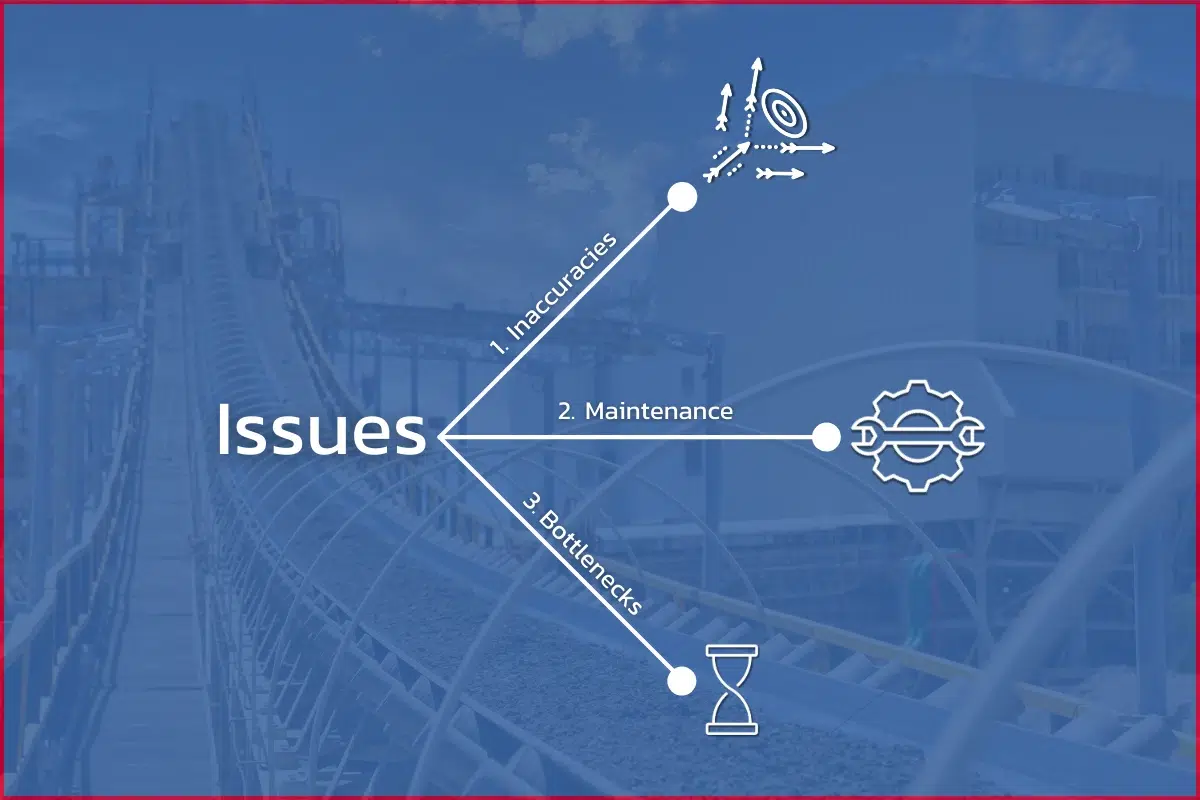
1. Conveyor Belt Scale Inaccuracies
Conveyor belt scale inaccuracies trigger major leaks in profits at mines all over the world, and here’s why:
Your scales might say one thing today and something different next week (thanks to wear and tear). This calibration drift leads to inconsistent readings and inaccurate weight data.
And that sneaky material buildup on your belt? It’s messing with your numbers more than you think.
And when you’re moving thousands of tons daily, even an infinitesimally tiny 1% error can cost you big time.
Ever tried reconciling inventory with these fluctuating numbers? Fun times, right?
2. Weighbridge Setup and Maintenance
Weighbridges measure the flow weight on your conveyor belt, one material segment at a time.
Now, let’s take an honest look at weighbridges for a minute.
Sure, they’re accurate… when they’re perfectly calibrated. But here’s what the manufacturers won’t tell you upfront:
You’ll need frequent calibration (and I mean frequent). Those maintenance costs?
They keep coming back like a bad habit. And if your operation changes?
Moving these beasts costs more than a new pickup truck.
When you’re searching for weighbridge alternatives, it’s usually because you’ve learned these lessons the hard way.
3. Platform Scale Operational Bottlenecks
Platform scales are stationary scales that trucks drive onto to measure their total loaded weight.
Although reliable for static loads, they often require things that can lead to inefficiency.
What do we mean by inefficiency?
It’s those platform scale bottlenecks making your operators get gray hair.
Every truck has to come to a dead stop.
You’ve got drivers sitting there burning fuel while waiting in line.
Your efficiency takes a hit with every single load.
And that line of trucks? It’s getting longer by the minute.
When it comes to ways to track quarry output, this can sometimes feel as efficient as using a teaspoon to move a stockpile.
Volumetric Scanning Benefits: Why Industry Leaders Are Making The Switch
A well-implemented industrial volumetric scanner can address many of the pain points mines and quarries face with traditional scales:
1. In-Motion Efficiency: An Ideal Traditional Scale Alternative
Volumetric scanning setups let trucks drive through at a steady, low speed.
This means eliminating delays associated with traditional platform scales where trucks must completely stop for weighing.
This higher throughput also minimizes idling fuel consumption and helps operators stay focused on moving material efficiently rather than managing queues.

2. Rich Data on Every Load: Smart Ways to Track Quarry Output
Traditional scales just throw numbers at you.
Now what about volumetric scanners?
They tell you the whole story. If you’re searching for ways to track quarry output, you’ll finally see what’s really happening with every load.
Most importantly, you’ll pinpoint underloading issues that quietly drain profits – a problem that costs mining operations millions each year.
Plus, you’ll catch those off-center loads wearing out your equipment and spot every bit of carryback material that used to disappear into your cost column.
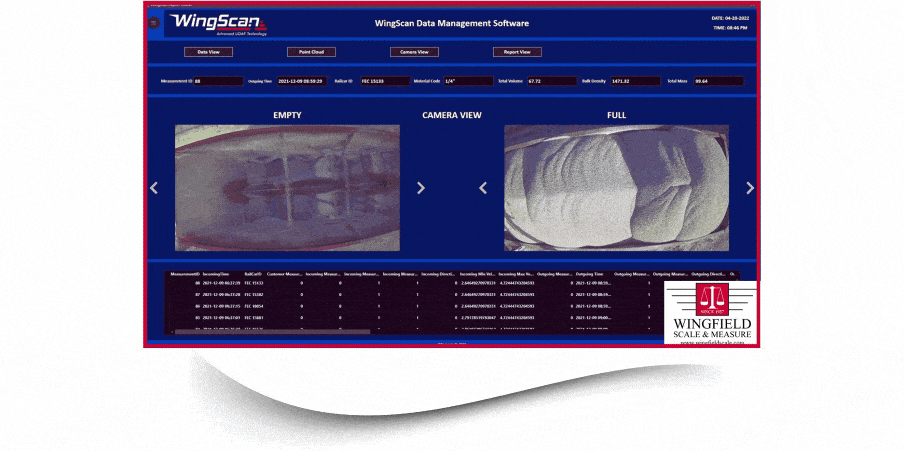
3. Lower Maintenance: Avoid Scale Inaccuracies
Simple truth: fewer moving parts mean fewer problems.
While platform scales, weighbridges, and belt scales need constant attention, volumetric scanning systems just need clean lenses.
Just a reliable operation, day after day.
4. Portable and Adaptable Volumetric Scanners
Your operation changes. Your measurement system should too.
When you need to expand or shift your loading site, these scanners move with you.
Try that with traditional belt scales, platform scales, or weighbridges – you’ll need major construction, serious downtime, and a budget that would make your CFO sweat.
Now, let’s see these systems side by side, so you can better explore the differences for yourself…
For a comprehensive analysis of the economic benefits of load volume scanning in underground mining, refer to this study.
Detailed Comparison: Volumetric Scanning vs Scale
From the pit to the scale house – here’s how volumetric scanning vs scale compare in real-world quarry operations:
|
Aspect |
Volumetric Scanning |
Traditional Scale |
|---|---|---|
|
Measurement |
Captures volume using 3D Laser profiling; |
Directly measures weight; volume must be inferred |
|
Accuracy |
Commonly ±1% on volume; can |
Accurate for weight (±0.5-1%) but prone to issues |
|
Speed & Throughput |
In-motion scanning; trucks do not |
Often requires stop-and-weigh for |
|
Installation |
Minimal civil works; many systems mount |
Requires a stable foundation or pit |
|
Maintenance |
Fewer moving parts. Basic care includes |
Load cells, mechanical parts, and belt mechanisms |
|
Data Insights |
Provides detailed 3D profiles and |
Offers basic weight data; advanced systems |
|
Portability |
Generally easy to relocate as the site changes or expands. |
Usually difficult to move; weighbridges and |
|
Best For |
High-efficiency operations looking for real-time volume tracking, |
Operations primarily focused on precise weight |
Choosing the Right Volumetric Scanning System: Scale Alternatives for Your Quarry
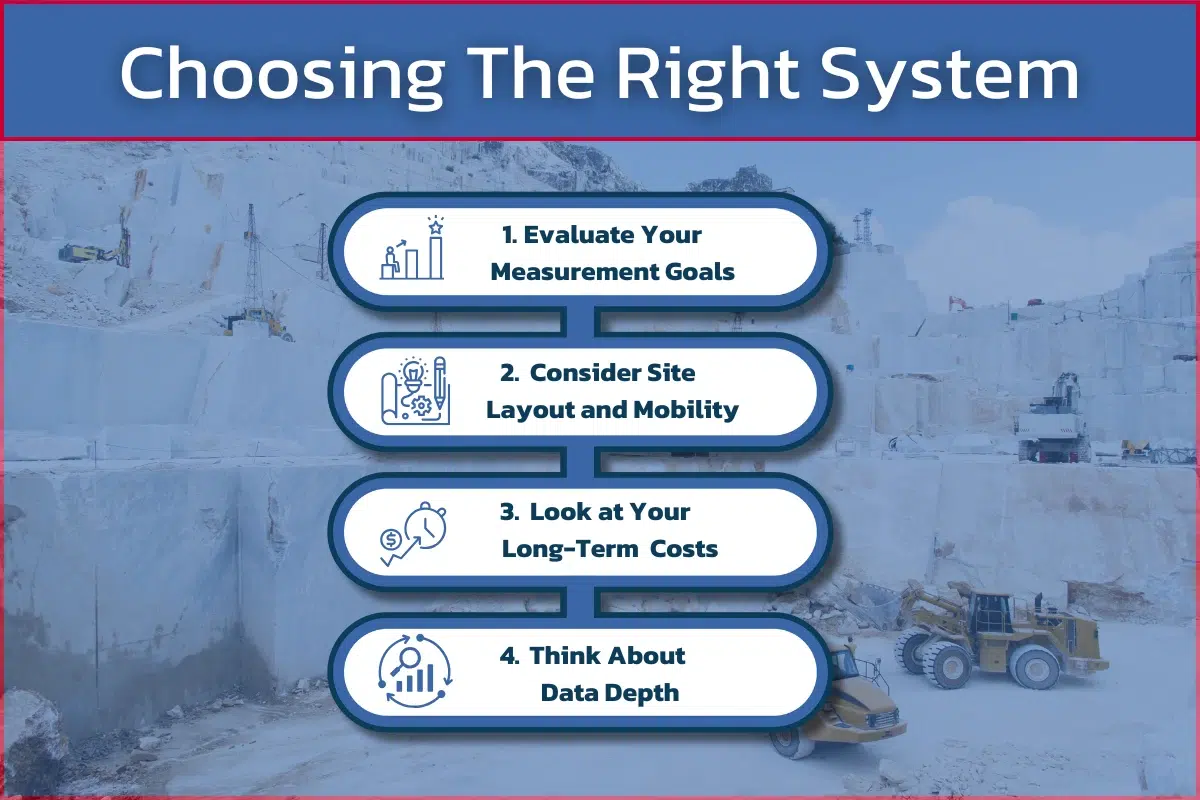
1. Evaluate Your Measurement Goals
Here’s what matters most: If you need certified weights for commercial transactions or compliance, both volumetric scanners and traditional scales (weighbridges, belt scales, or platform scales) will get the job done.
But if you’re looking to solve underloading issues, track exact load volumes, or get those deeper volumetric scanner benefits, an industrial load scanner gives you insights that traditional scales simply can’t match (across your haul trucks, conveyor belts, and railcars)
2. Consider Site Layout and Mobility
Your quarry layout today probably won’t be your layout next year.
If you’re running portable crushers or your pit keeps expanding (and who doesn’t?), volumetric scanners offer a flexible weighbridge alternative that moves right along with your operation. No fuss, no foundation work eating into your production schedule.
But, if you’ve got a very stable setup with a dedicated weighbridge, belt scale, and/or platform scale area that’s working for you, and you don’t see major changes ahead…
…maybe you just need to dial in what you’ve already got.
A well-calibrated and maintained scale in the right location can be worth its weight in aggregate.
3. Look at Long-Term Operational Costs
Let’s Talk Return on Investment – Will a volume scanner save you money?
Truth bomb: Weighbridges can be a real pain-in-the-unmentionables when it comes to upkeep.
All those calibrations and maintenance visits add up (not to mention the potential for downtime that eats into your bottom line).
Now, an industrial volume scanner? Think of it as the low-maintenance option.
Plus, no more production bottlenecks slowing you down!
So, if your trusty weighbridge is starting to feel like a money pit, it might be time to consider a change that puts you back in the driver’s seat.
4. Think About Data Depth
Let’s talk data.
Traditional scales? They’re like a basic black and white photograph. You get the general idea, but you’re missing other details.
Now, imagine a high-definition, full-color photograph. That’s what volumetric scanning gives you. It’s not just about the weight, it’s about the whole picture.
This scanner reveals load profiles, uncovers hidden patterns, and helps you spot problems before they become major headaches.
It’s kind of like having a detective on the job to uncover conveyor scale inconsistencies, operator errors, or even equipment malfunctions.
Think of it this way: With a basic scale, you might only notice a leak in your profits after it’s already drained your account.
But with this scanner, you can catch those leaks before they even start and implement better ways to track quarry output.
It’s the difference between seeing the forest and seeing the individual trees. And in today’s competitive landscape, seeing the individual trees in addition to the forest gives you the edge.
Final Thoughts On Volumetric Scanning Vs. Scale
Let’s be straight – there’s no one-size-fits-all solution here.
Some operations use weighbridges and platform scales for direct weight measurements. Others depend on belt scales for continuous conveyor monitoring.
And, a growing number are discovering the advantages of industrial volumetric scanners for quick volume measurements and detailed load analysis.
Here’s something interesting: With NTEP certification, volumetric scanners can now even fulfill regulatory and certified measurement roles traditionally held only by scales.
That’s a game-changer for many operations.
Smart operators are also getting creative, combining technologies to get the best of both worlds.
They’re using scanners to catch those conveyor belt scale inaccuracies and finding innovative weighbridge alternatives that actually work.
The real win? When you discover new ways to track quarry output, everything improves – fewer bottlenecks, simpler operations, and data that helps you make better decisions.
Speaking of Better Decisions…
Overcoming Scale Inaccuracies At Your Mine Site With WingScan Volumetric Scanning
Because you’re on this page, you probably know that gut-punch feeling when your traditional scales serve up numbers that just don’t add up?
We built WingScan to solve that exact problem.
Using advanced LiDAR technology, our volumetric scanner delivers:
Simple math: Better data = Smarter mining = Higher profits
Ready to see how it works in your operation?
Interested in learning how Wingfield can help your business?
Schedule a conversation with a wingfield specialist!
or call 423-698-0100
